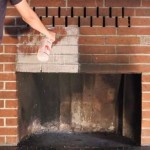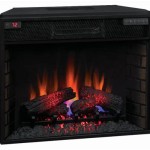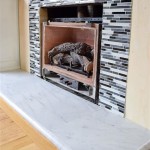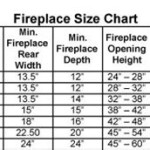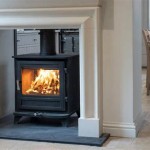Refacing a Brick Fireplace with Stacked Stone: A Comprehensive Guide
A brick fireplace, while often possessing a certain rustic charm, can sometimes appear dated or simply fail to complement a contemporary interior design. Refacing a brick fireplace offers an effective method to revitalize a living space and introduce a new aesthetic. Stacked stone, with its textured surface and natural variations, presents an increasingly popular option for fireplace refacing, lending a sophisticated and modern touch to any room.
This article provides a detailed guide on refacing a brick fireplace with stacked stone, covering essential aspects from preparation and material selection to installation and finishing touches. The information presented here is designed for the homeowner with a moderate level of DIY experience, though consulting with a qualified professional is always recommended, particularly for complex or structurally sensitive projects.
Assessing the Existing Fireplace Structure
Before embarking on any refacing project, a thorough assessment of the existing brick fireplace is crucial. The structural integrity of the fireplace must be carefully evaluated to ensure it can support the additional weight of the stacked stone. Look for any signs of cracking, crumbling, or water damage in the brickwork or mortar joints.
Any structural deficiencies must be addressed before proceeding. This may involve repairing loose bricks, patching damaged mortar, or even consulting with a structural engineer to determine the extent of the problem and recommend appropriate solutions. Ignoring these issues could compromise the safety and longevity of the refaced fireplace.
Beyond structural integrity, the condition of the existing brick surface also needs consideration. The surface must be clean, sound, and free of any loose debris or coatings that could interfere with the adhesion of the stacked stone. Remove any paint, varnish, or other finishes using appropriate solvents or mechanical methods. A wire brush can be effective in removing loose mortar and surface dirt.
Finally, it is essential to verify the fireplace's compliance with local building codes and regulations. Fire codes often stipulate specific clearances and safety measures for fireplaces, especially concerning combustible materials. Ensure the refacing project adheres to all applicable regulations to avoid potential safety hazards and legal complications.
Selecting the Appropriate Stacked Stone and Materials
Choosing the right type of stacked stone is paramount to achieving the desired aesthetic and ensuring the longevity of the refaced fireplace. Stacked stone is available in a wide variety of materials, colors, textures, and sizes, ranging from natural stone to manufactured stone veneers.
Natural stone offers a unique and authentic look, with variations in color and texture inherent to the material. Common types of natural stacked stone include slate, quartzite, and granite. Natural stone is generally more expensive and heavier than manufactured stone veneers, requiring a stronger adhesive and potentially additional structural support. Weight considerations are particularly critical when working with higher stacked fireplace designs.
Manufactured stone veneers, also known as faux stone, are made from concrete or other composite materials. They offer a more consistent appearance and are typically lighter and less expensive than natural stone. Manufactured stone veneers are also easier to cut and install, making them a popular choice for DIY projects. They also come in a wider range of colors and styles to match a variety of home décor.
In addition to the stacked stone itself, other essential materials include: thin-set mortar specifically formulated for stone veneer, a notched trowel for applying the mortar, a wet saw or angle grinder with a diamond blade for cutting the stone, a level, spacers to maintain consistent joint widths, and grout (if desired) for filling the joints between the stones.
The thin-set mortar must be suitable for both the type of stone being used and the substrate (the existing brick surface). Some thin-set mortars are specifically designed for vertical applications, providing better adhesion and preventing the stone from slipping during installation. It's crucial to read the manufacturer's instructions carefully to ensure proper mixing and application. Always verify the mortar is rated for the temperature experienced by the fireplace, especially around the firebox.
Installing the Stacked Stone: A Step-by-Step Guide
The installation process involves meticulous preparation and careful execution to achieve a professional-looking result. The following steps outline the general procedure for installing stacked stone on a brick fireplace:
1. Surface Preparation: Begin by thoroughly cleaning the brick surface, removing any loose debris, dirt, or previous finishes. If the brick is particularly smooth or non-porous, consider applying a bonding agent to promote better adhesion. This is a critical step to ensure the stone adheres correctly to the brick surface.
2. Layout and Planning: Before applying any mortar, dry-fit the stacked stone to determine the desired layout and arrangement. This allows for adjustments and ensures a visually appealing pattern. Pay particular attention to corners and edges, ensuring a clean and consistent look. Planning can help avoid small, awkwardly cut pieces at the end of the project.
3. Applying the Mortar: Mix the thin-set mortar according to the manufacturer's instructions. Using a notched trowel, apply a generous layer of mortar to the back of each stone, ensuring complete coverage. Also, apply a layer of mortar to the brick surface where the stone will be placed. Mortar should be wet enough to properly adhere to the stone and brick but not so wet as to cause it to slide. A damp sponge can clean up any excess mortar easily.
4. Setting the Stone: Carefully position the stone onto the brick surface, pressing firmly to ensure good contact with the mortar. Use spacers to maintain consistent joint widths between the stones. A level should be used frequently to make sure each stone is set straight and plumb. Some stacked stone products are interlocking, making this step easier.
5. Cutting the Stone: Use a wet saw or angle grinder with a diamond blade to cut the stone as needed to fit around corners, edges, and openings. Always wear safety glasses and appropriate hearing protection when cutting stone. This is often the most difficult part of the project and requires patience and precision.
6. Grouting (Optional): If desired, grout the joints between the stones after the mortar has cured for the recommended time (typically 24-48 hours). Apply the grout using a grout bag or grout float, filling the joints completely. Remove excess grout with a damp sponge, being careful not to smear the stone surface.
7. Curing and Sealing: Allow the mortar and grout (if used) to cure fully according to the manufacturer's instructions. Once cured, consider applying a sealant to the stacked stone to protect it from moisture and stains. This is particularly important for natural stone, which can be more susceptible to staining.
8. Fireplace Mantel Installation (Optional): A new mantel can really complete the look of a refaced fireplace. Make sure the mantel is installed at the correct height and is securely fastened to the wall. The mantel material should be non-combustible or have adequate fire protection based on local building codes. There are many retailers that can supply fireplace mantels for this type of project.
Following these steps diligently will contribute greatly to a successful and visually appealing stacked stone fireplace refacing project. Always prioritize safety and consult with qualified professionals when necessary.

Reface A Fireplace With The Look Of Stone Or Brick Barron Designs

Reface A Fireplace With The Look Of Stone Or Brick Barron Designs

Reface Fireplace Brick Makeover Home Remodel

Faux Stone Panels For Fireplaces

Refacing A Fireplace With Stone Veneer Horizon

How To Cover A Brick Fireplace With Stone

A Step By Guide To Fireplace Refacing Diy Family Handyman

Transform Your Fireplace With East West Classic Ledge Stone

Stone Selex Show Special 970 Fireplace Refacing Selexstone

Stone Fireplace Design And Remodel
Related Posts


